《修辞与翻译》课程复习提纲
- 格式:pdf
- 大小:177.55 KB
- 文档页数:7
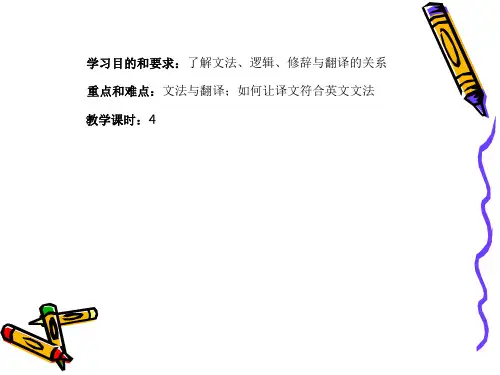
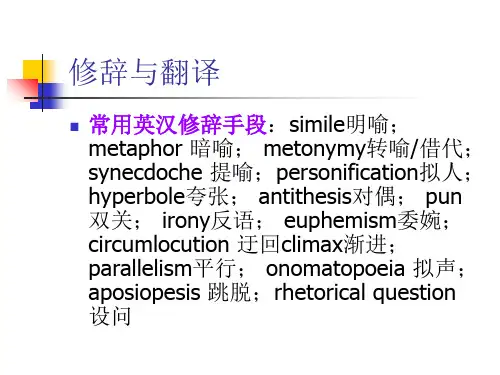
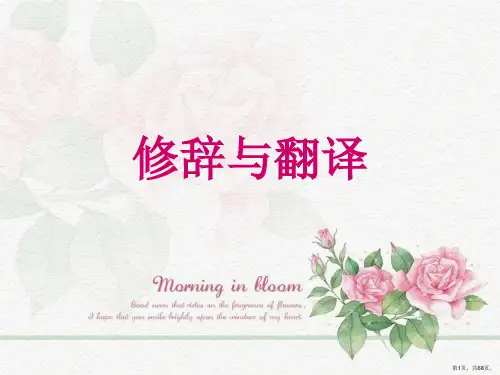
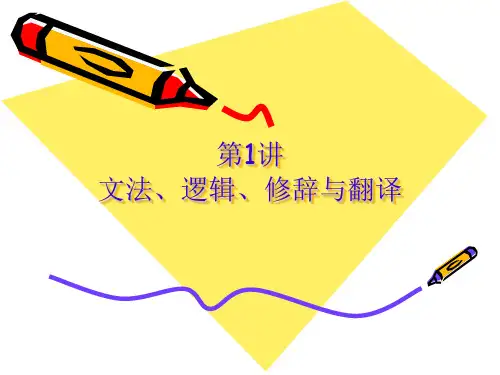
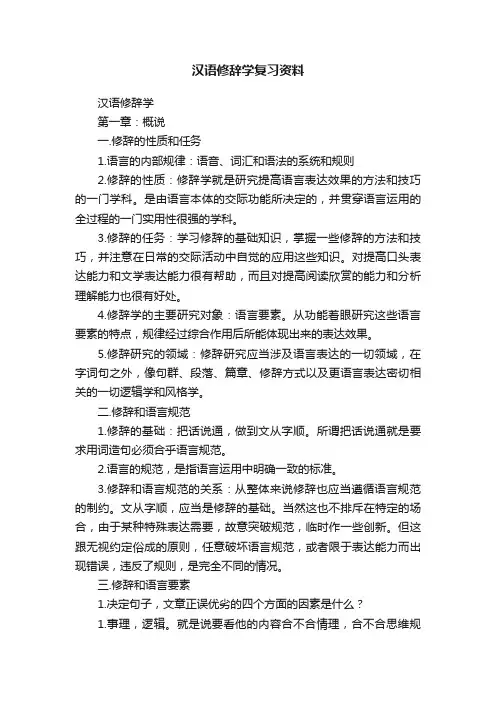
汉语修辞学复习资料汉语修辞学第一章:概说一.修辞的性质和任务1.语言的内部规律:语音、词汇和语法的系统和规则2.修辞的性质:修辞学就是研究提高语言表达效果的方法和技巧的一门学科。
是由语言本体的交际功能所决定的,并贯穿语言运用的全过程的一门实用性很强的学科。
3.修辞的任务:学习修辞的基础知识,掌握一些修辞的方法和技巧,并注意在日常的交际活动中自觉的应用这些知识。
对提高口头表达能力和文学表达能力很有帮助,而且对提高阅读欣赏的能力和分析理解能力也很有好处。
4.修辞学的主要研究对象:语言要素。
从功能着眼研究这些语言要素的特点,规律经过综合作用后所能体现出来的表达效果。
5.修辞研究的领域:修辞研究应当涉及语言表达的一切领域,在字词句之外,像句群、段落、篇章、修辞方式以及更语言表达密切相关的一切逻辑学和风格学。
二.修辞和语言规范1.修辞的基础:把话说通,做到文从字顺。
所谓把话说通就是要求用词造句必须合乎语言规范。
2.语言的规范,是指语言运用中明确一致的标准。
3.修辞和语言规范的关系:从整体来说修辞也应当遵循语言规范的制约。
文从字顺,应当是修辞的基础。
当然这也不排斥在特定的场合,由于某种特殊表达需要,故意突破规范,临时作一些创新。
但这跟无视约定俗成的原则,任意破坏语言规范,或者限于表达能力而出现错误,违反了规则,是完全不同的情况。
三.修辞和语言要素1.决定句子,文章正误优劣的四个方面的因素是什么?1.事理,逻辑。
就是说要看他的内容合不合情理,合不合思维规律。
2.规矩,习惯。
就是看他合不合词汇语法的规范,合不合大家说话的习惯。
3.情味,色彩。
看他的玉体风格合适不合适,感情色彩对头不对头。
4.声音,语气。
就是看他读起来顺口不顺口,听起来悦耳不悦耳,口气合适不合适。
2.修辞研究的重要课题:怎样运用这些语言材料及其规律来完美的表情达意。
3.修辞同语音,语汇和语法三者的关系。
1.汉语音节分明,并且有声、韵、调之分,这些语音特点为修辞提供了很好的条件,除了可以直接构成拟声,谐音等修辞方式之外,更常见的是在语言中组成大双声叠韵的词语和对帐押运的句式,使得语言节奏鲜明,音调铿锵,有很强的音乐感。
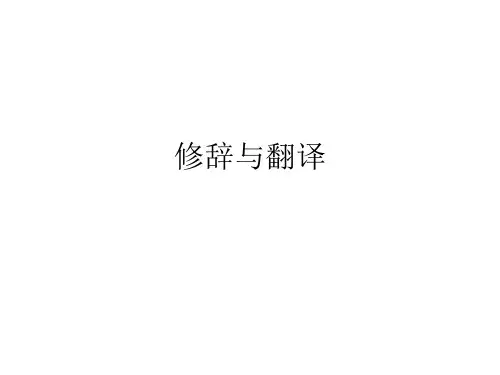

英语⽂体与修辞复习提纲(2020年整理).pdfPart OneChapter One Introducing Style1.1 What is Style?1.2 Style as Saying Different Things in Different Contexts1. sentence2. vocabulary1.3 Style as Speakers from Different Background1. social status2. social class3. race4. sex: biological; social5. time1.4 Style as Functions of Texts1. interview2. commentary1.5 The Stylistic Features1. sound features: pun; rhyme; alliteration; elision2. spelling: the elision of certain sounds; alternative pronunciation; mispronunciation; contraction3. words: contexts; nominalized word and their corresponding verbs and adjectives; the same field or domain4. grammar: the manipulation of syntactic structures; the use of parallel structures; sentences with different length and complexity5. meaning: fields; personification; hyprbole / litotes; irony / satireChapter Two Lexicology2.1 Morphemic Devices(qualitative deviation or incongruity & quantitative deviation or deflection)1. Neologism: affixation; compounding; derivation; conversion; blendingnonce words2. Overregularity and High Frequency of Occurrencehomoioteteuton2.2 Lexical Devices1. Selection of WordsFeatures of register: field; tenor; mode2. Classification of WordsRegister and dialectCommoncore words and words used in different varietisDialect: regional / of age, race, profession/ social structure / temporal3. Rhetorical SeriesSimilar in certain aspectsTwo / three / four or more items4. Word ImplicationsExtended, transferred meanings; with emotive colouring (neutral / positive / negative);synonymy (ideational / interpersonal / textual)5. Play with Meaning: Rhetorical DevicesMeaning transference (simile / metaphor / personification / metonymy); Meaning extension and Contraction (hyperbole / litotes or meiosis); Contradiction in Logic (oxymoron / paradox); Meaning Conversion; Play on Homonymy (pun) Chapter Three Grammar3.1 Syntactic Deflection1. The Unexpected High Frequency of OccurrenceLong sentences (vivid, rich, exuberant, luxurious)Short sentences (direct, terse, concise, clear effect or continuous, compact, swift effect)2. The Overregular Use of Certain Patterns or ModelsParallelisms; Antithesis; Chiasmus; Antistrophe; Repetition; Epizeuxis; Ploce3.2 Syntactic Incongruity1. Unusual Syntactic StructuresLoose Sentences; Periodic Sentences; Elliptical Sentences; Inverted Sentences; Rhetorical Questions2. Violation of the Grammatical RulesUngrammatical sentencesChapter Four Phonology and Graphology4.1 Phonology1. Sound and WritingTwo ways of representing the same thing / respective features2. Phonological theoryPhoneme: synaesthesiaIncongruity: phonological transference and elision ( aphesis, syncope, apocope)Sound Pattern: Alliteration; Assonance; Consonance3. SyllableSyllable Deflection: Para-rhyme; Reverse Rhyme; Rhyme (masculine rhyme vs. Feminine rhyme) (end rhyme & internal rhyme)Defeated Expectation4. FootMeter (foot) vs. rhythm (measure)Foot DeflectionMetrical Deviation: change stress; put stress on what should be an unstressed syllable; change the order; reduce the number of feet.Onomatopoeia: synaesthetic5. Tone Group6. Suprasegmental FeaturesStress; Intonation (falling and rising); Pause4.2 Graphology1. Graphological SystemFive ranks: grapheme, words, comma, colon, period.Three factors that can produce graphological prominence: marking, space and sequence2. GraphemePunctuation Marks: period, comma, exclamation marks, quotation marks, parenthesesEllipsis of Punctuation marks3. Ill-spelled words (erroneous spelling)4. Italics5. Spatial ArrangementChapter Five Semantics5.1 Cohesion and Style1. Reference: Personal; Demonstrative; ComparativeExophora (context-bound); Endophora (context-free; anaphora and cataphora)2. Substitution and EllipsisLiveliness; conciseness; terseness3. ConjunctionConjunctions and conjunctive phrases and adverbs4. Lexical Cohesion1) Reiteration: repetition; synonymy; hyponymy; meronymy2) Collocation: provides semantic thread linking the meanings of different sentences and words together5.2 Sentence Groups, Passages and Paragraphs1. Sentence Groups (SG): argumentation; narration; description2. Paragraphs and PassagesParataxis ; hypotaxisIndependent ; surbordinate ; transition3. Patterns of Text StructuresGenerical structure potentialA buying-selling situation: five obligatory elements A job-interview situation: five obligatory elements Fiction Writings: five or six stagesPart Two Practical Style。
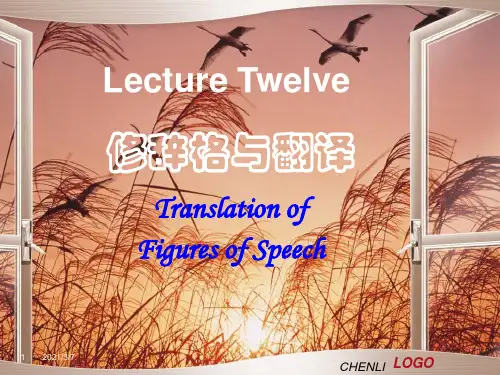
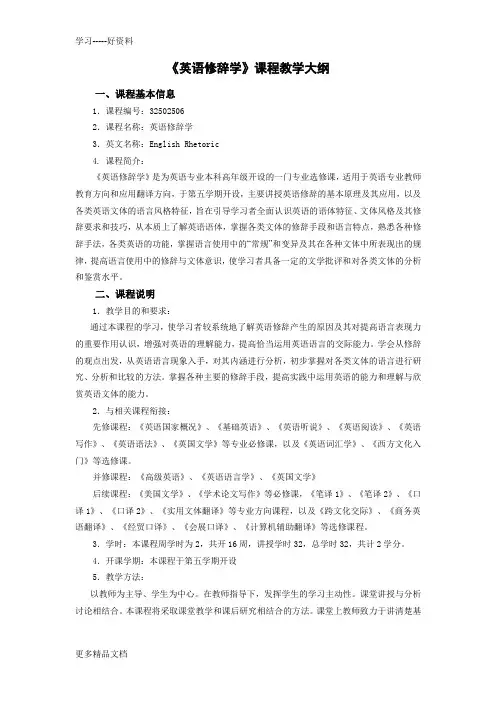
《英语修辞学》课程教学大纲一、课程基本信息1.课程编号:325025062.课程名称:英语修辞学3.英文名称:English Rhetoric4. 课程简介:《英语修辞学》是为英语专业本科高年级开设的一门专业选修课,适用于英语专业教师教育方向和应用翻译方向,于第五学期开设,主要讲授英语修辞的基本原理及其应用,以及各类英语文体的语言风格特征,旨在引导学习者全面认识英语的语体特征、文体风格及其修辞要求和技巧,从本质上了解英语语体,掌握各类文体的修辞手段和语言特点,熟悉各种修辞手法,各类英语的功能,掌握语言使用中的“常规”和变异及其在各种文体中所表现出的规律,提高语言使用中的修辞与文体意识,使学习者具备一定的文学批评和对各类文体的分析和鉴赏水平。
二、课程说明1.教学目的和要求:通过本课程的学习,使学习者较系统地了解英语修辞产生的原因及其对提高语言表现力的重要作用认识,增强对英语的理解能力,提高恰当运用英语语言的交际能力。
学会从修辞的观点出发,从英语语言现象入手,对其内涵进行分析,初步掌握对各类文体的语言进行研究、分析和比较的方法。
掌握各种主要的修辞手段,提高实践中运用英语的能力和理解与欣赏英语文体的能力。
2.与相关课程衔接:先修课程:《英语国家概况》、《基础英语》、《英语听说》、《英语阅读》、《英语写作》、《英语语法》、《英国文学》等专业必修课,以及《英语词汇学》、《西方文化入门》等选修课。
并修课程:《高级英语》、《英语语言学》、《英国文学》后续课程:《美国文学》、《学术论文写作》等必修课,《笔译1》、《笔译2》、《口译1》、《口译2》、《实用文体翻译》等专业方向课程,以及《跨文化交际》、《商务英语翻译》、《经贸口译》、《会展口译》、《计算机辅助翻译》等选修课程。
3.学时:本课程周学时为2,共开16周,讲授学时32,总学时32,共计2学分。
4.开课学期:本课程于第五学期开设5.教学方法:以教师为主导、学生为中心。
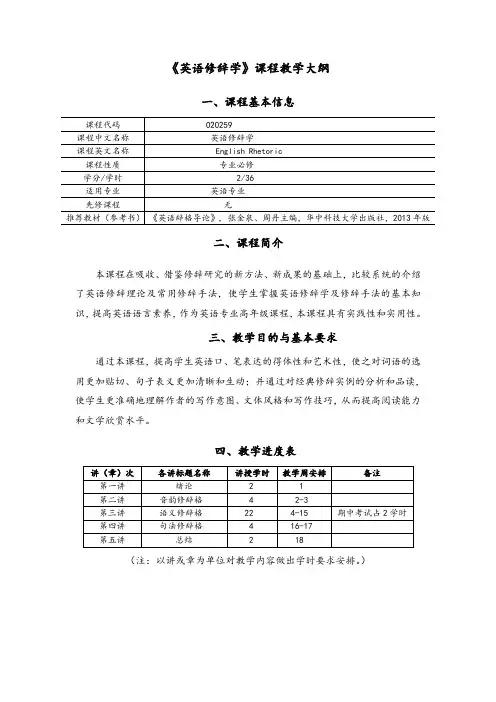
《英语修辞学》课程教学大纲一、课程基本信息课程代码020259课程中文名称英语修辞学课程英文名称English Rhetoric课程性质专业必修学分/学时 2/36适用专业英语专业先修课程无推荐教材(参考书)《英语辞格导论》, 张金泉、周丹主编,华中科技大学出版社,2013年版二、课程简介本课程在吸收、借鉴修辞研究的新方法、新成果的基础上,比较系统的介绍了英语修辞理论及常用修辞手法,使学生掌握英语修辞学及修辞手法的基本知识,提高英语语言素养,作为英语专业高年级课程,本课程具有实践性和实用性。
三、教学目的与基本要求通过本课程,提高学生英语口、笔表达的得体性和艺术性,使之对词语的选用更加贴切、句子表义更加清晰和生动;并通过对经典修辞实例的分析和品读,使学生更准确地理解作者的写作意图、文体风格和写作技巧,从而提高阅读能力和文学欣赏水平。
四、教学进度表讲(章)次各讲标题名称讲授学时教学周安排备注第一讲绪论 2 1第二讲音韵修辞格 4 2-3第三讲语义修辞格 22 4-15 期中考试占2学时第四讲句法修辞格 4 16-17第五讲总结 2 18(注:以讲或章为单位对教学内容做出学时要求安排。
)五、考核方式和成绩评定办法1、考核方式:闭卷考;2、成绩评定办法:平时成绩(包括课堂表现、提交作业、考勤)占30%,期中考试占10%,期末考试占60%六、内容提要第一周英语修辞学概述教学目的:1)了解修辞学定义及修辞学研究的历史;2)了解修辞学学习的意义及课程设置教学重点:修辞学研究的对象及意义教学难点:修辞的定义教学方法:讲授为主,结合学生讨论教学内容:1)修辞学定义2)修辞学研究历史概述3)英语辞格介绍4)英语修辞学学习的意义5)本门课程考核方式课后思考题:英专学生学习英语修辞学的意义授课时数:2第二周音韵修辞格(头韵、元韵)教学目的:理解并掌握头韵、元韵概念与具体运用教学重点:头韵教学难点:头韵、元韵的具体运用教学方法:教师讲授、学生讨论、课堂联系presentation相结合教学内容:1)头韵定义及修辞实例赏析2)元韵定义及修辞实例赏析授课时数:2第三周音韵修辞格(押韵、拟声)教学目的:理解并掌握押韵、拟声的概念与具体运用教学重点:押韵教学难点:押韵、拟声的具体运用教学方法:教师讲授、学生讨论、课堂联系presentation相结合教学内容:1)押韵定义及修辞实例赏析2)拟声定义及修辞实例赏析授课时数:2第四周语义修辞格(摹色)教学目的:理解并掌握摹色的概念与具体运用教学重点:颜色词教学难点:摹色具体运用教学方法:教师讲授、学生讨论、课堂联系presentation相结合教学内容:摹色定义及修辞实例赏析授课时数:2第五周语义修辞格(明喻)教学目的:1)掌握明喻的概念2)掌握明喻的几种常见形式3)了解as...as...类明喻的翻译教学重点:明喻的几种常见形式教学难点:as...as...类明喻的特征及文化内涵教学方法:教师讲授、学生讨论、课堂联系presentation相结合授课时数:2第六周语义修辞格(隐喻)教学目的:1)掌握隐喻的定义2)掌握隐喻的分类3)了解延伸式隐喻的定义教学难点:隐喻的分类教学方法:教师讲授、学生讨论、课堂联系presentation相结合授课时数:2第七周语义层面的修辞格(拟人、双关)教学目的:1)掌握拟人的概念、分类、修辞效果。

《英语修辞学》课程教学大纲一、说明(一)本课程的目的、要求(1)使学生较系统地了解英语修辞产生的原因及其对提高语言表现力的重要作用认识,增强对英语的理解能力,提高恰当运用英语语言的交际能力。
(2)使学生学会从修辞的观点出发,从英语语言现象入手,对其内涵进行分析,初步掌握对语言进行研究、分析和比较的方法。
(3)使学生掌握各种主要的修辞手段,提高实践中运用英语的能力和理解与欣赏英语文学作品的能力。
(二)内容选取和实施中注意的问题(1)本课程应坚持理论与实践相结合的原则,适当介绍修辞理论,重点讲述实用性内容,要求学生运用所学理论分析语言实例。
(2)突出重点、兼顾一般。
在选取内容上要注意以语音、词汇、句子三级修辞方法为重点,其中又应以喻类辞格为重点。
(3)学生对明喻比较熟悉,可以略而不讲或只作为隐喻的比较对象略谈。
(4)培养学生对语言的观察能力,让学生自己寻找例句并作出说明,以加深对所学内容的理解。
(5)大纲中不带“*”号的内容属于基本内容,带“*”号内容可讲可不讲。
(三)教学方法(1)教师为主导、学生为中心。
防止教师一言堂,要在教师指导下,发挥学生的学习主动性。
(2)理论与实践相结合,课堂讲授与学生分析讨论相结合。
(四)考核方式本课程为考查课程,采用口头与笔头相结合的方式:(1)口头方式主要以课堂提问和课堂讨论表现情况为考核依据。
(2)笔头方式主要以学生平时笔头作业完成情况和课程结束时笔头测验成绩为考核依据。
(3)口头考核成绩占40%,笔头考核成绩占60%。
(五)教学内容与学时分配二、大纲内容Chapter 1 What Is Rhetoric?1.1 Rhetoric and oratory1.2 Connotation of rhetoric1.3 Definitions of rhetoric1.4 Five assumptions说明和要求:(1)了解修辞与演说之间的关系(2)修辞学的定义Chapter 2 Brief History of Western Rhetoric2.1 Classical rhetoric (5th c. B.C.---5th c. A.D.)2.2 Rhetoric in the Middle Ages (5th---14th c.)*2.3 Rhetoric in the Renaissance (15th---16th c.) *2.4 New Classical Rhetoric (17th---19th c.)2.5 Contemporary Rhetoric说明和要求:(1)了解西方修辞学产生与发展的历史(2)了解亚里士多德等学者对西方修辞学的贡献(3)了解当今修辞学发展的现状和主要趋势Chapter 4 Choice of Words4.1 Use suitable words4.2 Denotation and connotation4.3 General words and specific words4.4 Abstract words and concrete words4.5 Short words and long words说明和要求:(1)了解词的本义与衍生义(2)了解概括词与特指词的语用功能(3)了解抽象词和具体词的语用功能(4)了解大词和小词的来源和对语体色彩的影响Chapter 5 Choice of Sentences5.1 Types of sentences5.2 Long and short sentences说明和要求:(1)了解不同句子结构的修辞作用(2)了解长句和短句的语用功能Chapter 7 Phonetic Figures of Speech7.1 Alliteration7.2 Assonance7.3 Consonance7.4 Onomatopoeia7.5 Aposiopesis7.6 Apostrophe7.7 Pun说明和要求:(1)本部分从语音在语言中的地位讲起,适当介绍语音学方面的知识,重点提示音韵法在诗歌中所起的重要作用及其对散文、广告等各语体的影响。
《英语修辞学》课程教学大纲一、说明适用专业四年制本科英语专业语言文学方向先修课程高级英语总学时32总学分2(一)本课程的目的、要求(1)使学生较系统地了解英语修辞产生的原因及其对提高语言表现力的重要作用认识,增强对英语的理解能力,提高恰当运用英语语言的交际能力。
(2)使学生学会从修辞的观点出发,从英语语言现象入手,对其内涵进行分析,初步掌握对语言进行研究、分析和比较的方法。
(3)使学生掌握各种主要的修辞手段,提高实践中运用英语的能力和理解与欣赏英语文学作品的能力。
(二)内容选取和实施中注意的问题(1)本课程应坚持理论与实践相结合的原则,适当介绍修辞理论,重点讲述实用性内容,要求学生运用所学理论分析语言实例。
(2)突出重点、兼顾一般。
在选取内容上要注意以语音、词汇、句子三级修辞方法为重点,其中又应以喻类辞格为重点。
(3)学生对明喻比较熟悉,可以略而不讲或只作为隐喻的比较对象略谈。
(4)培养学生对语言的观察能力,让学生自己寻找例句并作出说明,以加深对所学内容的理解。
(5)大纲中不带“*”号的内容属于基本内容,带“*”号内容可讲可不讲。
(三)教学方法(1)教师为主导、学生为中心。
防止教师一言堂,要在教师指导下,发挥学生的学习主动性。
(2)理论与实践相结合,课堂讲授与学生分析讨论相结合。
(四)考核方式本课程为考查课程,采用口头与笔头相结合的方式:(1)口头方式主要以课堂提问和课堂讨论表现情况为考核依据。
(2)笔头方式主要以学生平时笔头作业完成情况和课程结束时笔头测验成绩为考核依据。
(3)口头考核成绩占40%,笔头考核成绩占60%。
(五)教学内容与学时分配教学章节教学内容学时安排备注1修辞学定义22西方修辞学简史44词语的选择35句子的选择27语音类修辞格48-9句法类修辞格610语义类修辞格611逻辑类修辞格4机动2测验二、大纲内容Chapter 1 What Is Rhetoric?1.1 Rhetoric and oratory1.2 Connotation of rhetoric1.3 Definitions of rhetoric1.4 Five assumptions说明和要求:(1)了解修辞与演说之间的关系(2)修辞学的定义Chapter 2 Brief History of Western Rhetoric2.1 Classical rhetoric (5th c. B.C.---5th c. A.D.)2.2 Rhetoric in the Middle Ages (5th---14th c.)*2.3 Rhetoric in the Renaissance (15th---16th c.)*2.4 New Classical Rhetoric (17th---19th c.)2.5 Contemporary Rhetoric说明和要求:(1)了解西方修辞学产生与发展的历史(2)了解亚里士多德等学者对西方修辞学的贡献(3)了解当今修辞学发展的现状和主要趋势Chapter 4 Choice of Words4.1 Use suitable words4.2 Denotation and connotation4.3 General words and specific words4.4 Abstract words and concrete words4.5 Short words and long words说明和要求:(1)了解词的本义与衍生义(2)了解概括词与特指词的语用功能(3)了解抽象词和具体词的语用功能(4)了解大词和小词的来源和对语体色彩的影响Chapter 5 Choice of Sentences5.1 Types of sentences5.2 Long and short sentences说明和要求:(1)了解不同句子结构的修辞作用(2)了解长句和短句的语用功能Chapter 7 Phonetic Figures of Speech7.1 Alliteration7.2 Assonance7.3 Consonance7.4 Onomatopoeia7.5 Aposiopesis7.6 Apostrophe7.7 Pun说明和要求:(1)本部分从语音在语言中的地位讲起,适当介绍语音学方面的知识,重点提示音韵法在诗歌中所起的重要作用及其对散文、广告等各语体的影响。
Unit 4 Rhetoric TranslationLesson 16 Rhetoric and Translation1. Rhetoric translation方梦之(2005:50-57)修辞与翻译翻译是一种双语转换的艺术。
仅仅掌握词汇、语法和背景知识(包括专业知识)还不够。
通过翻译,要求传达原语中所包含的各种信息,其中自然包括语言形式所表示的修辞意义及文体风格。
大部分英语常用修辞格都能在汉语找到相似甚至相同的修辞方式,而相似之中又各又特点。
由于双方历史、文化(包括美学观点)、习俗的不同,在表达同一概念时,有时使用不同的修辞格;即使采用同个修辞格,例如比喻,在结构方式、运用范围方面也不尽相同。
修辞手段时翻译过程中运用的主要语言手段之一。
译品质量跟修辞形式的正确运用很有关系。
例如培根(F. Bacon)的散文结构严谨,对仗工整,尤其以三项式排比著称。
他的“Of Studies”第二段的开首句是:To spend too much time in studies is sloth; to use them too much for ornament is affectation; to make judgment wholly by their rules is the humour of a scholar.翻译家王佐良不但传其“神”,而且表其“形”。
他的译文式:读书费时过多易惰,文采藻饰太盛则矫,全凭条文断事乃学究故态。
译者不但忠实地传达了原文,而且运用了对应的修辞手段再现了原文的审美功能。
句式均衡匀称式一种美。
各种语言都具有这样的美。
汉语由于用方块字,无词形变化,有声调变化,加上同音字多等原因,比其他语言更容易做到结构匀称。
“话有三说,巧说为妙”结构匀称固然是巧妙的,但是还有许多富于变化的句式和修辞格,只要使用得当,也是巧妙的。
概括的说,修辞式调整文章的表里关系,式思路感情的表现、客观事物情景的反映能恰如其分,无过无不及。
Match the English name of rhetorical devices with their Chinese name.1. alliteration A. 头韵2. allusion B. 引喻3. analogy C. 类比4. euphemism D. 委婉语5. metaphor E. 暗喻6. personification F 拟人7. pun G. 双关语8. simile H. 明喻9. ellipsis I. 省略10. parallelism J. 排比Fortune favors fools. 傻人有傻福----Alliteration 头韵whee-ee-ee! The police whistles shrilled suddenly .---Onomatopoeia 拟声Noah and his Ark 诺亚方舟-----Allusion 引喻Penny wise and pound foolish 小事聪明,大事糊涂----Antithesis对偶OH!Freedom, you are the soul of our human beings! ---apostrophe 顿呼I admire her, I love her, I need her. ----Climax 层递I have lost my beau and my lipstick too. -----anticlimax 突降Sometimes it does rain and (it does rain) hard. ----Ellipsis 省略Where there’s a will, there’s a way ---epigram 警句Beauty is but skin-deep ---epigram 警句Taking the first step stars thousand-mile journey. ----epigram 警句The Wall Street is in a panic. -----metonymy 借喻a wise fool ----oxymoron 矛盾painful pleasure ------ oxymoron 矛盾The flowers nodded in the breeze. -----personification 拟人Thirsty soil drank in the rain. ---- personification 拟人We must hang together, or we shall all hang separately. ----pun 双关语Necessity has no law. -----ridicule 挖苦Some rise by sin, and some fall by virtue. -----satire 讽刺The poor man had six mouths to feed. -----synecdoche 提喻Appropriate praise to a child is what the sun is to a flower ---analogy 类比Happy dispatch 自杀式切腹自杀-----euphemism 委婉语It is a truth universally acknowledged that a single man in possession of a good fortune must be in want of a wife. -----periodic sentence 圆周句Bang goes my ace -----inversion 倒装I slept, and dreamed that life was beautyI woke, and found that life was duty -----couplet 对句O, captain! My captain, our fearful trip is done. -----apostrophe 顿呼As cold as ice ------simile 明喻Jim is a fox ------metaphor 暗喻I’ ve heard that a million times ----Hyperbole 夸张Her eyes were flooded with tears. ----- Hyperbole 夸张Simile; simile is a figure of speech which makes a comparison between two unlikeelements having at least one quality or characteristic in common.Metaphor; metaphor is a figure of speech in which an implied comparison is made between two unlike things that actually have something important in common.Analogy; analogy draws a parallel between two unlike things that have several commonIdentify the rhetorical devices according to the given definitions. (此题各位同学自己先看,上课时有问题再讨论)1. It’s repetition of an initial sound, usually of a consonant or cluster, in two or morewords of a phrase, line of poetry, etc.A. ParallelismB. MetonymyC. AlliterationD. Metaphor2. It’s a figure of speech containing an implied comparison, in which a word or phraseordinarily and primarily used of one thing is applied to another.A. MetaphorB. HyperboleC. SimileD. Personification3. It’s the humorous use of words, or of words w hich are formed or sounded alike butHave different meanings, in such a way as to play on two or more of the possible applications; a play on words.A. AllusionB. PunC. ClimaxD. Oxymoron4.It’s a figure of speech that consists in using the name o f one thing for that of something else with which it is associated.A. ParallelismB. MetonymyC. AlliterationD. Metaphor5. It’s a statement that is not strong enough to express facts or feelings with full force;or It’s a statement that expresses an idea, etc, too weakly.A. ParallelismB. ClimaxC. Rhetorical QuestionD. Understatement6.It’s a figure of speech in which something of an unpleasant, distressing, or indelicate nature is described in less offensive terms, as in the expressions “under the weather” for “ill” or “passed away” for died”.A. MetaphorB. HyperboleC. EuphemismD. Parallelism7. It refers to the repeating of any element in an utterance, including sound… a word or phrase, a pattern of accents.. or an arrangement of li nes…A. RepetitionB. AntithesisC. AlliterationD. Parallelism8. It’s a method of humorous or subtly sarcastic expression in which the intended meaning of the words used is the direct opposite of their usual sense.A. MetaphorB. HyperboleC. IronyD. Simile9. It’s a literary or artistic work that imitates the characteristic style of an author or a work for comic effect or ridicule.A. MetaphorB. PunC. SimileD. Parody10. A figure of speech in which a single word, usually a verb or adjective, is syntactically related to two or more words, with only one of which it seems logically connected.A. RepetitionB. AntithesisC. ZeugmaD. ParallelismCABBD, CACDC1.西方媒体对中国的许多报道是不正确的,有时是非常不客观的,是非常不公正的。
《汉语修辞学》期末复习大纲(2008年秋)一、考试课程名称与考试方式汉语言文学专业本科选修课《汉语修辞学》课程考试大纲,本课程闭卷考试,采用笔试方式。
二、本课程考试内容、基本要求与复习方法建议《汉语修辞学》是中央广播电视大学人才培养模式改革和开放教育试点的课程,是汉语言文学专业专科基础课"现代汉语"基础上的进一步提高。
本课程的教学目的是使学生在初步具备现代汉语修辞知识和能力的基础上进一步加深对汉语修辞学基本知识、基础理论的理解,掌握基本的修辞技巧,从而提高实际应用语言的水平。
本课程基本要求:(一)了解现代汉语修辞的基本概念和理论知识,在教学内容和理论体系上注意做好与"现代汉语课"的衔接。
这是最低层次的要求。
(二)理解汉语修辞学基本知识、基础理论,掌握基本的修辞技巧。
本课程的实践性很强,因此在进行基本知识理论的学习时,要注意通过分析实例来学习,注意与修辞实践的联系。
这是较高层次的要求。
(三)应用方面指教学的目的重在实践练习,讲求适用,做到学以致用。
修辞是一种创造性的语言实践活动,所以,本课程突出当前社会生活的修辞实践,通过引用当前口语、报刊、影视剧的修辞用例,突出修辞的时代感。
使学生通过课程基本知识的学习有切实的收获。
这是最高层次的要求。
三、考试试题的基本题型和所占分数比例1、填空题(每空1分,共10分)2、简答题(每题8分,共24分)3、指出下列各句中运用了什么修辞格(每题2分,共36分)4、应用分析题(每题15分,共30分)四、本课程期末复习的范围或各章节复习要点第一章修辞概说复习要点:本章着重说明修辞的一些基本问题,阐明修辞的性质,修辞同语境的密切关系。
重点掌握:修辞的性质、修辞同语境的关系。
一般掌握:修辞学的历史、修辞与语言三要素的关系、修辞与逻辑的关系。
一般了解:第三节社会生活需要修辞知识、第五节修辞是一种创造性活动、第六节修辞主体的修养、第七节在社会的大课堂里学习修辞。
《修辞与翻译》课程复习提纲l 关于西方修辞的基本认识修辞在西方指的既是通过语言及其他象征手段的技巧性利用改变他人的认识、态度、行为的社会实践,实现这一实践的目的的一种艺术,也是研究如何进行这一实践的一门学科。
n the art of speaking or writing effectively;the art of speaking well;the art of persuasion; the art of argumentation; the art of adapting discourse to its purpose;n the skill in the effective use of speechn the discipline devoted to the study of the rhetorical art修辞者/受众修辞形势/情境修辞意图/效果修辞资源/策略l 修辞与翻译的密切关系1. Lessons we have drawn:l criteria of translation are always audience-specific;l for C-E translation, the target audience can only be native readers of English;l we should guard against the tendency to mistake bilingual Chinese readers for the target audience of C-E translation.l a translation could be the right one sometimes, and a wrong one at other times; in translation, there can be no criterion of correctness/accuracy that transcends time, place, context, audience;l whether a translation is right or not depends on the purpose it is meant to servel the best translation is not the most correct translation, but the one which produces the greatest social, cultural, intellectual and cognitive effects.2. relevant theoretical perspectives[The translator should be concerned about] the expectations of the putative readership, bearing in mind their estimated knowledge of the topic and the style of language they use, . . . since one should not translate down (or up) to the readership. . . . On the basis of the variety of language used in the original, you attempt to characterise the readership of the original and then of the translation, and to decide how much attention you have to pay to the TL readers, (In the case of a poem or any work written primarily as self-expression the amount is, I suggest, very little). You may try to assess the level of education, the class, age and sex of the readership if these are ‘marked’ . (P. Newmark 1988: vii; )Translation is, of course, a rewriting of an original text. All rewritings . .. manipulate literature to function in a given society in a given way. Rewriting is manipulation, undertaken in the service of power, and in its positive aspect can help in the evolution of a literature and a society. Rewritings can introduce new concepts, new genres, new devices, and the history of translation is the history also of literary innovation, of the shaping power of one culture upon another. But rewriting can also repress innovation, distort and contain, and in an age of ever increasing manipulation of all kinds, the study of the manipulative processes of literature as exemplified by translation can help us towards a greater awareness of the world in which we live. (A. Lefevere 1992: xi)The first major example of the transformative impact of translation is the large-scale translation of Buddhist scriptures into Chinese. The enterprise begins around 70 CE and continues for almost nine centuries. . . . As Lin Kenan points out, the effect on Chinese culture was profound:‘Because Buddhism was introduced into China through translation, the commingling of and conflict between the exotic Buddhism and the native Confucianism and Taoism have set the foundation of Chinese thought’. . . .A second significant moment in the history of Chinese translation will be the arrival in numbers of Christian missionaries from the West, and in particular of Jesuit missionaries from the late sixteenth century onwards. The missionaries themselves saw the translation of Western texts into Chinese as a way of securing influence over the Chineseadministrative elite with a view to eventual religious conversion. . . .A third translation movement will be triggered by growing political instability in China due to the incursions of foreign powers around the period of what have become known as the Opium Wars in the 1840s. The interest in translation was prompted by a feeling that the country must either translate or perish. There was no way Western powers could be opposed if you did not understand the science behind their warfare or the politics behind their foreign policy. . . . In Kenan’s view, ‘this translation movement ideologically paved the way for the 1911 revolution that eventually overthrew the last feudal dynasty of China’(Cronin, 2006: 24-26)Rhetoric and Translation: A Course Overview《修辞与翻译》课程简介-- Situating itself necessarily in more than one rhetorical situation, centering on an interplay among radically different elements, and serving a diversity of purposes, translation is rhetoric par excellence. (翻译不可避免地涉及到不止一个修辞形势(情境)。